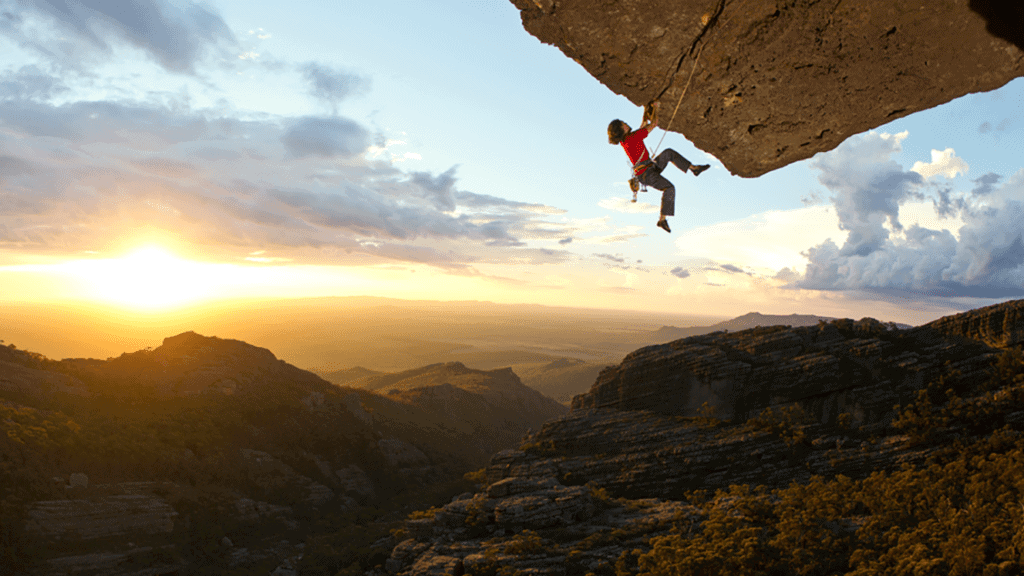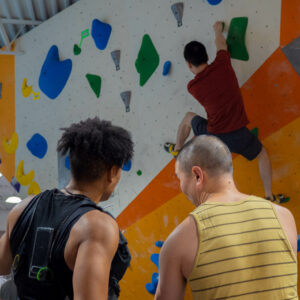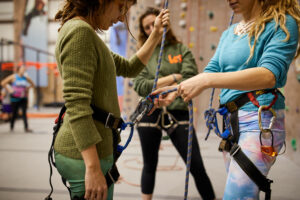
We covered the basics of introductory rock climbing gear—harnesses and shoes—in a separate blog article about what new climbers need to get started and gear recommendations, but what about gear for advanced climbers?
If you are looking to take things to the next level and transition from gym climbing to real rock in the great outdoors or are considering taking the next step by hopping on the sharp end for your first outdoor sport or even traditional lead, this article is for you. The experts at Vertical Rock Climbing and Fitness are here to walk you through what you need for outdoor bouldering and wall climbing.
What Outdoor Boulderers Need to Climb Real Rock Outside the Gym
As you may have noticed, bouldering gyms are padded to protect climbers from falling. We have covered the different types of climbing shoes, so as a boulderer, you probably have picked out a pair of aggressive shoes with a downturned toe and solid heel rubber and have a chalk bucket and brush as well since these are standard for most gym boulderers.
However, there are no pads outdoors, and often, the fall zones for the best boulder problems can be rocky, hard-packed, and dangerous. For this reason, outdoor boulderers use crash pads. They look like little fold out mattresses (and they can double for a couch, chair, or bed for a proper dirtbag. They come in different sizes (most notably in a tri-fold or one-fold style). Bouldering pads are an essential piece of safety equipment for any outdoor boulder (even for highballs!). Our recommendation for a beginner is the Metolius Session II Crash Pad. Standard fair for intro to outdoor bouldering.
Outdoor Climbing: Roped Climbing Gear
Outdoor rope climbing requires more gear than bouldering. In a previous article, we covered shoe and harness choices. Here, we will cover belay and rappel devices, ropes, and the critical hardware needed for leading both sport and traditional climbs. We will assume that you already have a harness, shoes, and chalk bag.
Outdoor Gear: Rope Climbers Need Climbing Ropes
We will cover the basics here. One of the first significant things to know about ropes is that there are two main types: static and dynamic. These ropes are used for very different things, and it is vital to know the difference. Static ropes are meant for top ropes and fixed lines only—they can also be used when you need to extend a rope anchor from a far distance.
You must lead climb with a dynamic rope and not a static one. Static ropes cannot provide you with a soft catch. Leading with a static can cause you injury if you take a whip. It is
important to distinguish between the two. Aside from this, you will need to decide whether you want a 60 or 70-meter rope (dependent on your objectives) and what brand. Choosing a rope with a well-defined middle mark will help make setting up rappels easy. This blogger suggests choosing a distinctly bi-patterned rope along with a blatant middle mark. Consider looking into Dynacore for the added confidence. Rope diameters can also range. It is best to pick a rope in the 9.0 and up range to start.
Belay and Rappel Devices: Tried and True
These days, there are many different types of belay and rappel devices on the market—and in this climber’s opinion, many of them are unnecessary and complicated. The tried and true equipment recommendations are the GrivGri 2 (or a comparable Petzel GriGri) and a standard ATC guide. These are the only two rappel and belay devices you will ever need.
A Gri Gri is a more intelligent choice for belayers because it auto-locks. While not wholly immune to human error, the Gri Gri is easy to use and a great option for top belaying, climbers with slight weight differences, top belaying, and even for simul-rappelling situations when they arise. They are also used for hauling and even rescues. An ATC guide is helpful for double rope rappelling when climbing single and multi-pitch and is a great backup to have if you drop or misplace your Gri Gri as it can be used to belay as well. Guide mode is excellent for belaying from above on two strands of rope.
Climbing Hardware: Quick Draws, Alpine Draws, Quads, Cams, and More
Beyond the basics, if you are looking to lead traditional or sport climbs, you will need the proper climbing gear. Sport climbers use quickdraws, clipping them to fixed bolts and feeding the rope through them for protection to a fixed anchor where a quad or draws will be used for anchor to lower off the hardware at the end of the route.
Traditional climbers require a bit more hardware than sport climbers do. While trad climbers may clip the occasional fixed bolt, piton, or pin found on route primarily, camming devices made by companies like Black Diamond, Totem, and Metolius along with nuts (a more passive type of protection). This hardware is placed into cracks in the rock and the rope is clipped through a carabiner or alpine draw if the protection needs to be extended. Trad climbers also often need to build anchors, which requires using cams and nuts along with rated cord material (recommended 6-7mm) and locking carabiners.
Are you interested in getting your friends, partner, or spouse into climbing? Consider having your next birthday party at the rock gym. Vertical Rock Climbing and Fitness in Northern Virginia encourages adult birthday parties. The gym also offers classes for climbers looking to transition from the gym to real rock outside. Visit our website to learn more, or drop by one of our gyms!



